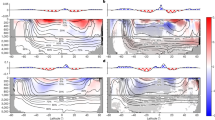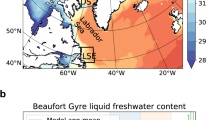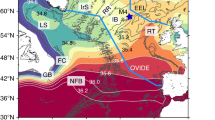Abstract
Between 1965 and 1990, the waters of the Nordic Seas and the subpolar basins of the North Atlantic Ocean freshened substantially1. The Arctic Ocean also became less saline over this time, as a consequence of increasing runoff1,2,3,4, but it is not clear whether flow from the Arctic Ocean was the main source of the Nordic Seas salinity anomaly. As a region of deep-water formation, the Nordic Seas are central to the Atlantic meridional overturning circulation, but this process is inhibited if the surface salinity is too low2. Here we use the instrumental record of Nordic Seas hydrography, along with a global ocean–sea-ice model hindcast simulation, to identify the sources and magnitude of freshwater that has accumulated in the Nordic Seas since 1950. We find that the freshwater anomalies within the Nordic Seas can mostly be explained by less salt entering the southern part of the basin with the relatively saline Atlantic inflow, with seemingly little contribution from the Arctic Ocean. We conclude that hydrographic changes in the Nordic Seas are primarily related to changes in the Atlantic Ocean. We infer that if the Atlantic inflow and Nordic Seas both freshen similarly, this would render the Atlantic meridional overturning circulation relatively insensitive to Nordic Seas freshwater content.
This is a preview of subscription content, access via your institution
Access options
Subscribe to this journal
Receive 12 print issues and online access
$259.00 per year
only $21.58 per issue
Buy this article
- Purchase on Springer Link
- Instant access to full article PDF
Prices may be subject to local taxes which are calculated during checkout




Similar content being viewed by others
References
Curry, R. & Mauritzen, C. Dilution of the Northern North Atlantic Ocean in recent decades. Science 308, 1772–1774 (2005).
Pawlowicz, R. A note on seasonal cycles of temperature and salinity in the upper waters of the Greenland Sea Gyre from historical data. J. Geophys. Res. 100, 4715–4726 (1995).
Wentz, F. J., Ricciardulli, L., Hilburn, K. & Mears, C. How much more rain will global warming bring? Science 317, 233–235 (2007).
Peterson, B. J. et al. Trajectory shifts in the Arctic and Subarctic freshwater cycle. Science 313, 1061–1066 (2006).
Serreze, M. C. et al. The large-scale freshwater cycle of the Arctic. J. Geophys. Res. 111, C11010 (2006).
Hansen, B. & Østerhus, S. North Atlantic–Nordic Seas exchanges. Prog. Oceanogr. 45, 109–208 (2000).
Holliday, N. P. et al. Reversal of the 1960s to 1990s freshening trend in the northeast North Atlantic and Nordic Seas. Geophys. Res. Lett. 35, L03614 (2008).
Eldevik, T. et al. Observed sources and variability of Nordic Seas overflow. Nature Geosci. 2, 406–410 (2009).
Dickson, R. et al. Current estimates of freshwater flux through Arctic and Subarctic seas. Prog. Oceanogr. 73, 210–230 (2007).
Rudels, B. et al. The interaction between waters from the Arctic Ocean and the Nordic Seas north of Fram Strait and along the East Greenland Current: Results from the Arctic Ocean-02 Oden expedition. J. Mar. Sys. 55, 1–30 (2005).
Våge, K. et al. Revised circulation scheme north of the Denmark Strait. Deep-Sea Res. I 79, 20–39 (2013).
Proshutinsky, A., Bourke, R. H. & McLaughlin, F. A. The role of the Beaufort Gyre in Arctic climate variability: Seasonal to decadal climate scales. Geophys. Res. Lett. 29(23), 2100 (2002).
Dickson, R. R., Meincke, J., Malmberg, S. A. & Lee, J. A. The “Great Salinity Anomaly” in the northern North Atlantic 1968–1982. Prog. Oceanogr. 20, 103–151 (1988).
Belkin, I. M., Levitus, S., Antonov, J. & Malmberg, S-A. “Great Salinity Anomalies” in the North Atlantic. Prog. Oceanogr. 41, 1–68 (1998).
Steele, M. & Ernold, W. Steric sea level change in the northern seas. J. Clim. 20, 403–417 (2007).
Sundby, S. & Drinkwater, K. On the mechanisms behind salinity anomaly signals of the northern North Atlantic. Prog. Oceanogr. 73, 190–202 (2007).
Boyer, T. et al. Changes in freshwater content in the North Atlantic Ocean 1955–2006. Geophys. Res. Lett. 34, L16603 (2007).
Reverdin, G. North Atlantic subpolar gyre surface variability (1895–2009). J. Clim. 23, 4571–4584 (2010).
Nilsen, J. E. Ø., Hátún, H., Mork, K. A. & Valdimarsson, H. The NISE Dataset Technical Report No: 08–01 (The Faroese Fisheries Laboratory, 2008).
Mauritzen, C. Production of dense overflow waters feeding the North Atlantic across the Greenland–Scotland Ridge. Part 1: Evidence for a revised circulation scheme. Deep-Sea Res. I 43, 769–806 (1996).
Behrens, E. The Oceanic Response to Greenland Melting: The Effect of Increasing Model Resolution Dissertation, Christian-Albrechts-Universität, Kiel (2013); http://www.macau.uni-kiel.de/receive/dissertation˙diss˙00013684?lang=en
Hátún, H., Sandø, A. B., Drange, H., Hansen, B. & Valdimarsson, H. Influence of the Atlantic subpolar gyre on the thermohaline circulation. Science 309, 1841–1844 (2005).
Orvik, K. A. & Skagseth, Ø. The impact of the wind stress curl in the North Atlantic on the Atlantic inflow to the Norwegian Sea toward the Arctic. Geophys. Res. Lett. 30(17), 1884 (2003).
Curry, R. HydroBase 2–a Database of Hydrographic Profiles and Tools for Climatological Analysis, Technical Reference, Preliminary Draft (2001); www.whoi.edu/science/PO/hydrobase
Lozier, M. S., Owens, W. B. & Curry, R. G. The climatology of the North Atlantic. Prog. Oceanogr. 36, 1–44 (1995).
Large, W. & Yeager, S. The global climatology of an interannually varying air–sea flux data set. Clim. Dynam. 33, 341–364 (2009).
Lique, C., Treguier, A. M., Scheinert, M. & Penduff, T. A model-based study of ice and freshwater transport variability along both sides of Greenland. Clim. Dynam. 33, 685–705 (2009).
Desbruyères, D., Mercier, H. & Thierry, V. On the mechanisms behind decadal heat content changes in the eastern subpolar gyre. Prog. Oceanogr. http://dx.doi.org/10.1016/j.pocean.2014.02.005 (in the press).
de Boisséson, E., Thierry, V., Mercier, H. & Caniaux, G. Mixed layer heat budget in the Iceland Basin from Argo. J. Geophys. Res. 115, C10055 (2010).
Våge, K. et al. Significant role of the North Icelandic Jet in the formation of Denmark Strait overflow water. Nature Geosci. 4, 723–727 (2011).
Acknowledgements
The observational data was provided by the Marine Research Institute; Institute of Marine Research; the Faroese Fisheries Laboratory; and the Geophysical Institute, University of Bergen, through the NISE project.
Author information
Authors and Affiliations
Contributions
M.S.G. did the analyses, produced the figures and wrote the manuscript. T.E. supplied the initial idea for this study, produced figures and contributed to writing. J.E.Ø.N. provided the observational data and support in using the data and produced figures. E.B. provided the model simulation. All authors contributed ideas, discussed the results and clarified the implications throughout the study.
Corresponding author
Ethics declarations
Competing interests
The authors declare no competing financial interests.
Rights and permissions
About this article
Cite this article
Glessmer, M., Eldevik, T., Våge, K. et al. Atlantic origin of observed and modelled freshwater anomalies in the Nordic Seas. Nature Geosci 7, 801–805 (2014). https://doi.org/10.1038/ngeo2259
Received:
Accepted:
Published:
Issue Date:
DOI: https://doi.org/10.1038/ngeo2259
This article is cited by
-
Future strengthening of the Nordic Seas overturning circulation
Nature Communications (2023)
-
Low-frequency variability of surface air temperature over the Barents Sea: causes and mechanisms
Climate Dynamics (2016)
-
Connecting the Seas of Norden
Nature Climate Change (2015)
-
Freshened from the south
Nature Geoscience (2014)



